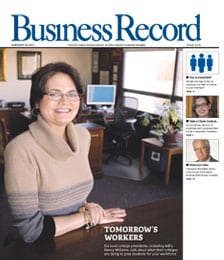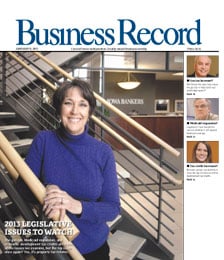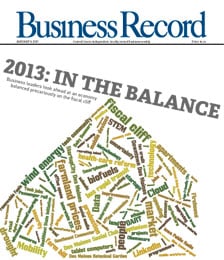Taxpayer group’s agenda reflects budget woes

The Iowa Taxpayers Association’s legislative agenda lacks the momentum that came with last year’s big push for venture capital legislation, but issues no less important to Iowa businesses shape it, ITA President Stacey L. Johnson said.
The state’s budget problems have tempered the ITA’s priorities. “If the budget wasn’t so tight, you might see us coming harder at capital gains again,” Johnson said. In 2001, the ITA backed legislation that would have allowed a one-time 50 percent deduction on capital gains realized by employees who had worked for Iowa companies in business for at least three years. The legislation carried a $3 million cap, but was vetoed by the governor in 2001 and didn’t move forward in the Legislature in 2002.
Johnson thinks similar legislation will be introduced this year, and the ITA will support it. “Unfortunately, I don’t see it moving forward,” she said.
The group’s top priority is its opposition to any tax increases, either statutorily or through administrative interpretation, Johnson said. Also high on the ITA’s list is elimination of the machinery and equipment sales and use tax on repair and replacement parts without regard to the useful life of such parts. That’s a big issue with Iowa manufacturers, Johnson said, because of problems in the auditing process of calculating the useful life of a replacement part. The ITA also supports expansion of the M&E tax exemption to include telecommunications infrastructure equipment used in commercial telecommunications operations.
The group also backs seven principles of accountable government included in the Accountable Government Act of 2001 it believes should be followed in crafting the state budget. Those standards are:
o Avoid the use of one-time or time-limited sources for ongoing expenses;
o Avoid implementation of new programs for a partial fiscal year;
o Avoid multiyear accelerating financial commitments;
o Avoid new automatic or “standing” appropriations;
o Accurately determine revenues and expenses;
o Align expenses and revenues in the same fiscal year;
o Avoid shifting program funding to property taxes or fees.
On Friday, the ITA will release its report on how well Iowa government adhered to those standards in development of the fiscal year 2003 budget.
The ITA also supports sales and use tax simplification, but does not support the Streamlined Sales Tax Project, which is looking at uniform definitions within tax bases, simplification of audit and administrative procedures, and utilization of emerging technologies to reduce the burdens of tax collections for companies engaged in remote commerce within the 50 states. Senate File 2321, passed in 2002 and signed into law by Gov. Tom Vilsack, formalized Iowa’s involvement in the Streamlined Sales Tax Project and established a delegation of Iowans, including one state representative, one senator, the Department of Revenue and Finance director and an appointee made by the governor, to help draft recommendations. The SSTP has finalized its Streamlined Sales and Use Tax Agreement and will recommend that legislatures in all 50 states adopt it this year.
The ITA says efforts to simplify states’ sales and use tax laws will be one of the most important tax reforms ever presented to Iowa businesses, but the group’s concerns haven’t been fully addressed in the proposal that will come before legislators this session. The group will continue to work with the Iowa Department of Revenue and Finance on the issue.
As always, property tax reform is an important priority for the ITA. Last year, a House Ways and Means subcommittee couldn’t reach consensus on House File 514, introduced in 2001 to limit property tax growth among Iowa counties. A tax-limitation law passed by the Legislature in 1992 expired in 1998, and counties were able to increase their levies even though mandated funding may have declined due to increased state funding for services such as mental-health care.
Senate File 514 would take into consideration funding the state has picked up, such as that for mental-health care, but it would require counties to fulfill promises to reduce property taxes made to voters when local-option sales taxes were passed. County governments would still be able to use unspent balances or unlevied taxing authority to deal with unanticipated expenses, but would be encouraged to reduce unnecessarily high cash reserve balances. The ITA says the legislation would eliminate dramatic swings in taxation caused by valuation changes without shifting tax burdens between classes of property. County budgets would still be allowed to grow at the rate of inflation and the value of new construction within the county. If additional money were needed, established limits could be exceeded by voter approval.
The ITA says the current property tax system has resulted in extraordinary increases in the ending balances of some counties’ cash reserve accounts. In 1994, the group says, the excess cash on hand for all Iowa counties versus what their combined budgets requested was approximately $400 million, or 37 percent in excess of the counties’ total spending that year. By 1999, that cash reserve total had swelled to $650 million, or 50 percent more than the total spending budgeted by Iowa’s county governments.
Similar budgeting practices occur in municipalities around the state, according to the ITA, although the group doesn’t think the cumulative effect is as dramatic as is seen on the county level.
The ITA also supports tax credits for businesses offering or subsidizing on-site day care; community development tax credits for businesses making charitable contributions to projects benefiting disadvantaged neighborhoods and communities; and a corporate income tax credit for businesses providing supplemental income or benefits to workers called to active duty as military reservists.
The group opposes the implementation of an appraisal fee to cover the cost of calculating the value of centrally assessed properties. It also opposes legislation that would continue collection of the administrative surcharge of $7 per employee to fund 56 rural workforce development offices around the state after enabling legislation expires on July 1.







